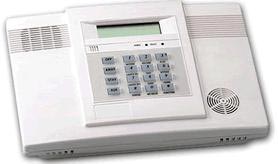| INTERNET-BASED
OPENING AND CLOSING
At
CENTRALARM, with our state-of-the-art technology,
customers can go online and check, at any time, the openings,
closings, alarm signals, etc., that have occurred in their
business, office or home.
If you prefer, we can provide at your request a report of
the days, times and code numbers of the people who opened
and/or closed your establishment or home, as well as the alarms
reported by the control panel. This report can be sent in
writing or via e-mail.
HOW
TO ACCESS CENTRALARM'S WEBSITE AND SEE YOUR ACCOUNT TRANSACTIONS
• Go to CENTRALARM's website www.centr-alarm.com
• Click once on Acceso
a Clientes.
• Register as a new user by following the simple steps
indicated by our web Access page.
IMMEDIATE
RESPONSE
If
you get an alarm signal, our operators will get immediately
in touch with you and/or with a persona appointed by you to
report the cause of this signal, while calling the police,
fire department or medical services if needed.
MAINTENANCE
SERVICE
Periodically
or upon request we will make visits to check the proper operation
of your alarm system. If you get an additional component for
your alarm system, we will install it free of charge.
CHANGING
SECURITY CODES
If,
for security reasons, you need to modify your code or cancel
any registered codes, CENTRALARM, through
its Central System, will provide an immediate response after
getting your request and at no additional charge. If you forget
your personal code, we can reset it immediately.
What's
an Alarm System?
It is an electronic device that acts as defense against
any kind of theft. The main function of an alarm system
is to advert the non-authorized intruder entrance
or entrance attempt. These system combines the perimeter
and interior protection of your property. Each access
door or window should stay protected with some kind
of sensor.

|

The inside of your property is protected with movement
sensors. The most common type of sensor detects the
presence of a person by comparing body temperature to
the room temperature. There are different types of alarms,
according to your needs they may be WIRED or WIRELESS.
Wired alarms are fully cabled and are more commonly
used for businesses or warehouses. Wireless alarms don't
use any wires and are therefore recommended for finished
homes to preserve cosmetic appearance.
|
Components of an alarm system
KEYPAD:
This device has numbered keys that are used to enable
and/or disable the alarm system. It can be LED based
or have a text display.
MOVEMENT
SENSOR:
This device provides internal protection for the property.
It identifies the presence of people inside.
MAGNETIC
CONTACT: This is the first defense against
an intrusion attempt. They determine whether a door
or window has been opened.
BACK-UP
BATTERY: It keeps your alarm system operating
in the event of a power outage.
CONTROL
PANEL: A Control Panel or Brain is the core
of the system, as it controls the overall operation
of the equipment. The Control Panel or Brain is actually
an electronic card with protected circuits in a cabinet.
HORN:
If your alarm system is activated, this will announce
the unauthorized entrance of an intruder to your property
by sounding a horn.
|
Monitoring
System
This is a supplement to the alarm system, which verifies
the status of the system 24/7 through signals that
are sent to the monitoring central over the phone
line and/or other communication devices (radio, cellular
transmission, Internet, etc.), reporting, among other
things: Openings, closings, theft, fire, medical emergencies,
police, power outages, robbery signals, etc.

|
|
How
it works
When your alarm system is activated and an event takes
place, whether an intrusion or a robbery, the alarm
panel captures the phone line and issues a signal
to the central monitoring station. The panel sends
data over the phone line that are received and recognized
by a device known as a receiver, which sends the alarm
information to the CENTRAL MONITORING COMPUTER, where
it is interpreted, processed and presented to an operator
who will take action.
In
the event of an intrusion, robbery, fire or medical
emergency, the operator can try to verify the event
by calling the monitored site and will then call the
emergency services (police, fire department and ambulance).
The operators can also send medical help or firefighters
and will notify the people appointed by the user,
according to a phone list prepared when the Monitoring
Service is hired.
|
 |
An
electronic security system (alarm) has three parts:
1.- Sensing (sensors)
2.- Processing (central, keypad)
3.- Response (lights, horn, monitoring)
1.
Sensing
a) Indoor: This is basically done with movement sensors.
b)
Perimeter: With magnetic opening sensors. Less often,
glass breaking and photoelectric sensors are used.
|
|
An ideal protection uses both indoor
and perimeter sensing. If only indoor sensors are used,
the response will be produced once the thief is inside
the property, and if the site is a residence, these
sensing areas cannot work when there are people inside,
and protection is only enabled when there's nobody in
the house.
If
only perimeter sensors are used, you can sleep peacefully,
because if an intruder tries to get in, there will be
an immediate response, but if the place is empty and
there is an opening, the perimeter will not be protected
as it has been violated.
With
the proper use of the two systems you eliminate the
cross risks of each individual system, because one covers
the shortcomings of the other.
|
2.
Processing
To do this, there is an alarm central, preferably
it should be installed in a hidden place, and at least
one keypad is installed to enable, disable and manage
the system.
The
alarm system should have a maintenance-free battery
system with enough autonomy to sustain the system
during a power outage.
About
the type of central, all centrals work, but it should
be chosen to meet the standards, because that's the
only thing that assures a quality standard and future
security.
|
|
If
the system will be installed in a small business or
in a small home with only one way in, it will be enough
to use one keypad installed by the entrance, near the
door. On the other hand, if the property has several
floors and has an independent service entrance, a keypad
should be installed in the secure area near a bedroom
where, in the event of a robbery, people can lock themselves
in to await help.
In
this case, through indications in the keypad, it will
be possible to know where the intrusion took place and
whether there's movement and where. Furthermore, through
pulsers in the keypad, a help call will be sent out.
More keypads should be added to any additional independent
entrances.
|
3.
Response
This is what makes everything else necessary. Locally,
in the event of an intrusion attempt or of a fire alarm,
one or more hidden alarms will sound inside the home
and a strobe light can be added on the outside so that
when the police come, they can identify the place quickly. |
|
|
Finally, MONITORING IS WHAT
TURNS AN ALARM INSTALLATION INTO A SECURITY SYSTEM,
since in the event of an alert, not only will there
be a sound alarm, but also, instantaneously and automatically,
the monitoring central will get a signal, notifying
the police and the persons listed by the owner in each
case.
At
the monitoring central, events are followed up by specially
trained employees who will follow every directive.
Monitoring
is not only a fundamental support for a theft alarm,
but the only solution to respond to robbery attempts,
fires, medical emergencies, etc., while also
permanently checking electric circuits, batteries, antisabotage
circuits, power outages, etc., which allows us, through
ongoing technical checks, to make sure that the alarm
system is always operational and alert to perform its
function.
When
an alarm is not monitored, it is isolated and its future
operation cannot be guaranteed unless all of its circuits
and zones are checked periodically.
|
|

